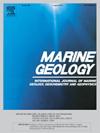塔斯马tid海山链的地貌演化
IF 2.2
3区 地球科学
Q2 GEOSCIENCES, MULTIDISCIPLINARY
引用次数: 0
摘要
海洋火山根据其所经历的地貌条件,形成了不同的爆发后形态。淹没、截断、平顶的火山被称为 "盖奥特"(Guyots),是海洋侵蚀和沉降的结果,而在暗礁或碳酸盐盖火山上,碳酸盐的增生则是火山顶的表皮。利用新的和现有的测深数据,确定了澳大利亚东海岸外的热点链 Tasmantid 海山链中不同地貌形式的海洋火山,其年代从南部的 6 Ma 到北部的 50 Ma。长轴和短轴的剖面和坡度计算提供了形态测量值,在此基础上确定了四种形态:海山、盖奥特、现代礁和碳酸盐盖奥特。据估计,在海洋岩石圈上喷发的火山的平均沉降速度为 46.5 mMyr-1,快于在大陆岩石圈上喷发的火山的沉降速度(33.0 mMyr-1)。据估计,盖奥特的平均侵蚀速度为 1.9 ± 0.5 kmMyr-1。在 11 座火山的山顶上形成了大量的碳酸盐沉积,厚度从北部的 1146 米到南部的 93 米不等。自渐新世以来,Tasmantid 海山链的地貌演变被归纳为一个概念模型。该研究发现,海山链中每座火山的爆发后形态都是澳大利亚板块北移、侵蚀、沉降和碳酸盐增生共同影响的产物。本文章由计算机程序翻译,如有差异,请以英文原文为准。
The geomorphic evolution of the Tasmantid Seamount Chain
Oceanic volcanoes develop distinct post-eruptive morphologies depending on the geomorphic conditions they experience. Submerged, truncated, flat-topped volcanoes, known as guyots, result from marine erosion and subsidence, whereas on reefs or carbonate-capped volcanoes, carbonate accretion veneers the summit. New and existing bathymetric data are utilised to identify different geomorphic forms of oceanic volcanoes in the Tasmantid Seamount Chain, a hotspot chain off the east coast of Australia, dated from ∼6 Ma in the south to >50 Ma in the north. Profiles and slope calculations across long and short axes provide morphometric values on the basis of which four morphologic forms are identified: seamount, guyot, modern reef, and carbonate-capped guyot. Volcanoes which erupted on oceanic lithosphere are estimated to have subsided at an average rate of 46.5 mMyr−1, faster than the subsidence rate of volcanoes that erupted on continental lithosphere (33.0 mMyr−1). The guyots are estimated to have eroded at an average rate of 1.9 ± 0.5 kmMyr−1. Substantial carbonate accretion has formed on the summits of eleven volcanoes, ranging in thickness from 1146 m in the north to 93 m in the south. The geomorphic evolution of the Tasmantid Seamount Chain, since the Oligocene, is synthesised into a conceptual model. This study finds that the post-eruptive morphology of each volcano in the chain is a product of the combined influence of the northward movement of the Australian Plate, erosion, subsidence, and carbonate accretion.
求助全文
通过发布文献求助,成功后即可免费获取论文全文。
去求助
来源期刊

Marine Geology
地学-地球科学综合
CiteScore
6.10
自引率
6.90%
发文量
175
审稿时长
21.9 weeks
期刊介绍:
Marine Geology is the premier international journal on marine geological processes in the broadest sense. We seek papers that are comprehensive, interdisciplinary and synthetic that will be lasting contributions to the field. Although most papers are based on regional studies, they must demonstrate new findings of international significance. We accept papers on subjects as diverse as seafloor hydrothermal systems, beach dynamics, early diagenesis, microbiological studies in sediments, palaeoclimate studies and geophysical studies of the seabed. We encourage papers that address emerging new fields, for example the influence of anthropogenic processes on coastal/marine geology and coastal/marine geoarchaeology. We insist that the papers are concerned with the marine realm and that they deal with geology: with rocks, sediments, and physical and chemical processes affecting them. Papers should address scientific hypotheses: highly descriptive data compilations or papers that deal only with marine management and risk assessment should be submitted to other journals. Papers on laboratory or modelling studies must demonstrate direct relevance to marine processes or deposits. The primary criteria for acceptance of papers is that the science is of high quality, novel, significant, and of broad international interest.
 求助内容:
求助内容: 应助结果提醒方式:
应助结果提醒方式:


